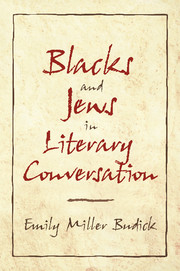Book contents
- Frontmatter
- Contents
- Acknowledgments
- Introduction: “Because you were strangers in the land”
- 1 Mutual Textual Constructions of Black–Jewish Identity
- 2 Crisis and Commentary in African–Jewish American Relations
- 3 Race, Homeland, and the Construction of Jewish American Identity
- 4 Cultural Autonomy, Supersessionism, and the Jew in African American Fiction
- 5 “The Anguish of the Other”: On the Mutual Displacements, Appropriations, and Accommodations of Culture (Toni Morrison, Cynthia Ozick, William Styron, Philip Roth, Grace Paley, and the Jewish–American–Israeli Critic)
- Notes
- Index
2 - Crisis and Commentary in African–Jewish American Relations
Published online by Cambridge University Press: 06 July 2010
- Frontmatter
- Contents
- Acknowledgments
- Introduction: “Because you were strangers in the land”
- 1 Mutual Textual Constructions of Black–Jewish Identity
- 2 Crisis and Commentary in African–Jewish American Relations
- 3 Race, Homeland, and the Construction of Jewish American Identity
- 4 Cultural Autonomy, Supersessionism, and the Jew in African American Fiction
- 5 “The Anguish of the Other”: On the Mutual Displacements, Appropriations, and Accommodations of Culture (Toni Morrison, Cynthia Ozick, William Styron, Philip Roth, Grace Paley, and the Jewish–American–Israeli Critic)
- Notes
- Index
Summary
He was no longer a Negro or a Christian but had become a Jew.
Nella Larsen, PassingIn Chapters Three, Four, and Five I discuss a series of mutually constructing African and Jewish American fictions. Like Malamud's Tenants, these short stories and novels produce portraits of ethnic identity by utilizing materials of the other ethnic group. Now, however, I want to pursue a few more nonfictional conversations in the mutual construction of African and Jewish American identity. These conversations appear in a series of journal articles and books, most of them from the 1950s through the early 1970s. My focus is on the post-Second World War period, for several reasons. First of all, this is the period when Jews started to move into positions of power within American society. It is also the period when, possibly because of their newly gained strength but very likely also because of the questions of Jewish survival raised both by the Holocaust and the precarious existence of the State of Israel, they participated in large numbers in black movements.
The war was equally decisive for blacks. As the pages of The Crisis make exceedingly, bitterly, clear, American blacks had pinned their hopes for integration and social justice on their record in the war. The painfully disappointing experiences of demobilized black soldiers and their families directly fed the passions of Civil Rights activism in the postwar decades.
- Type
- Chapter
- Information
- Blacks and Jews in Literary Conversation , pp. 61 - 118Publisher: Cambridge University PressPrint publication year: 1998

